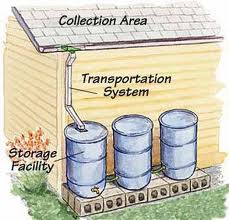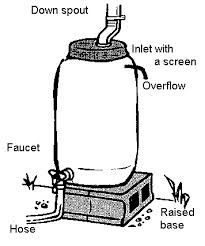Rain water needs to be rightly used to keep water scarcity problems at bay. Rain water harvesting is one of the ways of doing it and in continents like Asia and Africa, this technique is commonly approached. Moreover, this is being done since 2000 years in Thailand.
This water can be used for a number of purposes later, like for example, irrigation or even livestock.

Sometimes, in some rural areas, rain water harvesting can be used as an independent or as a main source of water but developed countries use it as an alternative.
It not only provides water during critical situations like droughts but saves the ground water too. Rain water is one of the purest sources of water and it is free from any salinity.
The run-off water is normally eliminated by using certain tactics, due to the presence of a large number of contaminants.

A floating draw-off mechanism is normally used to extract the clean water .This rain water may have to be properly treated before it can be used for the general purposes. Since the presence of any kind of waste or bird faeces can affect the purity of water, the rain water harvested has to be quality tested and treated.
Setting up a rain-water harvesting plant in an area is no rocket science. Any person with minimal or sufficient skills can do the job successfully.
The demand of water that is seen in a place can’t be overlooked when constructing the setup. Since rain water harvesting is mainly used in critical situations, the water that is harvested needs to satisfy the people’s demands and should be efficient enough.
Here are some quick tips on how to harvest rain water on your own.
You first need a rain water collector according to the requirements. Rain water barrels are of very little help as they can store very little water. Preferably, use the industrial 275 gallon container that is also called as IBC. Wash this container well so that there are no contaminants sticking inside.
It also requires many other materials.
Some of them being:
* A garden hose with a faucet.
*Wood to build a desired platform
*Gutter screen and fiberglass bug screen
Now the building techniques:
* Choose a proper location for the water tank!

Now this wholly depends on your opinion regarding which would be the best position to place the container.Try to make it on an elevated ground too. This has an added benefit of the water flowing with gravity.
You can also put it on the top of the roof. Always chose a better strategic position.
* The inlet of water needs to properly modified.
When you collect water you definitely don’t want any leaves or mud getting in. To avoid all this muck, you need to properly filter it before it gets into the container. This needs a filtering inlet.
An aluminum gutter screen has to be used here.
* Connect the drain to the garden:
You need a garden hose and a spigot to get this right. Fix the drain to the hose and then to a spigot and your flow from the system to the garden is all set to compete.
* Get the gutter work done!

It is necessary to route the gutters correctly to the opening of the rain water container. Use two gutter downspouts to bring the water to the entry of the container.
This is how you get the rain water harvesting system done. It could be done on a platform that is more sufficiently raised in order to make it more effective.
This could be very beneficial to you especially in case you want the water to be given to the garden. Else, you just need to fix the hose to the required place where you want the water to flow.
The maintenance of this tank is when the inspection of gutters is done. It must be done regularly to prevent any wastes getting blended with the pure water. Dirt, leaves and other accumulated materials have to be regularly removed. Moreover, there should also be proper fencing provided.
Advantages of rain water harvesting:

* They are very easy to be installed and anybody with a minimal knowledge can be trained to set this up.
* In the case of domestic usage, proper catchments on the roof of houses can collect the rain water. If the demand is more, this catchment storage needs to be enhanced.
Disadvantages:
* Since this mainly depends on the rainfall , there is a high level of uncertainty in its availability.
In certain areas where rainfall is low, this technique won’t be of any use.
Suitability with reference to urban or rural:
Since a very skilled person is not required, this could be set up in urban as well as rural areas. Manpower teamed with a decent amount of knowledge can be termed as sufficient.
Rain water harvesting is indeed a boon to areas where people face unfortunate water scarcity problems. When water is stored strategically in these reservoirs, they can be used even in cataclysmic situations like droughts. When we can get the purest form of rain water free of cost, I think we definitely need to make the best use of it.

Leave a Reply